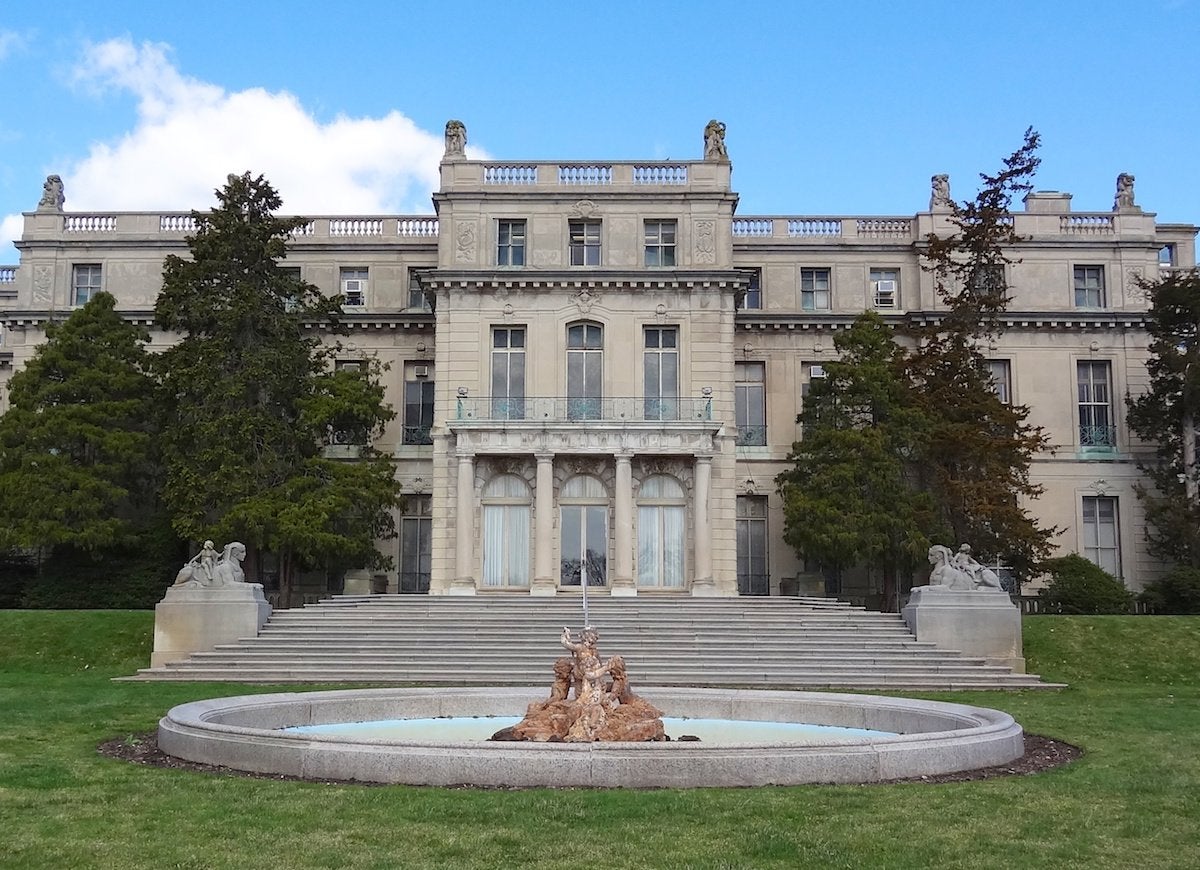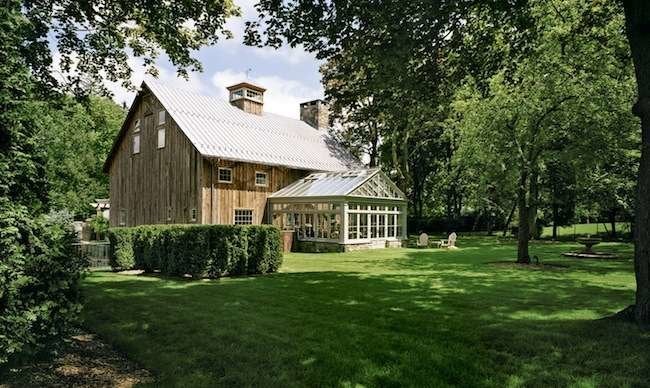We may earn revenue from the products available on this page and participate in affiliate programs. Learn More ›
Bellosguardo in Santa Barbara, California

Scenic views of the Pacific, a sprawling 23-acre plot, and 21,666 square feet of well-appointed rooms and furnishings—the Bellosguardo estate has it all—except someone to live in it. Neither the mansion’s former owner, reclusive heiress Huguette Clark, nor any of her immediate family members were seen visiting the property since the mid-1950s. And yet, the uninhabited mansion has remained in immaculate condition for the past 60 years, thanks to regular upkeep by the estate management team.
A. Everett Austin House in Hartford, Connecticut

wikimedia.org via Sage Ross
Don’t be fooled by the 86-foot wingspan of this stately Hartford home. Dubbed “The Facade House,” the historic home of famed art museum director A. Everett Austin is just 18 feet deep. The sprawling facade, so out of keeping for such a narrow house, is just one of this structure’s oddities. The imposing exterior is made not with brick and mortar, but rather pine board painted to mimic the ornate columned Italian villa-style residences seen in Europe in the early 20th century.
Related: The Best Tiny Homes of 2016
Winchester Mystery House in San Jose, California

The sunny yellow paint, ornamental gables, and perfectly groomed hedges of the Winchester Mystery House seem the epitome of a prim and proper Victorian home. But a haunting story of mystery and intrigue lies within these walls. Not only did the eccentric owner, Sarah Winchester, forgo the help of architects and inspectors, choosing to design the home without a formal blueprint, but tradition holds that she deliberately incorporated a slew of baffling architectural features into the property in an effort to confuse evil spirits. Earning its nickname “The House Built by the Spirits,” the Winchester Mystery House is rife with doors that go nowhere, stairs that lead to the ceiling, and even columns installed upside down!
Oheka Castle in Huntington, New York

wikimedia.org via Michael Fucci
If you can’t find a house on a hill, you may have to build the hill first (and then the house), which is exactly what financier Otto Kahn did in constructing Oheka Castle, completed in 1919. Before work on the structure began, two years were spent erecting a hill on the 443-acre plot so the 127-room mansion could enjoy views of nearby Cold Spring Harbor. Kahn was similarly demanding and innovative in his selection of architectural materials. Because one of his previous houses had been destroyed by fire, Kahn instructed his architects to use only fireproof materials for the 109,000-square-foot home, the second largest in the United States.
Rough Point in Newport, Rhode Island

wikimedia.org via Giorgio Galeotti
The eccentricity of late tobacco heiress Doris Duke permeates every room of her English Manor-style mansion, Rough Point. Her opulent bedroom is finished with eye-popping yellow walls, deep violet curtains, and resplendent mother-of-pearl furnishings. The upper walls of the upstairs hallway are adorned with tropical Zuber prints as colorful as Duke’s personality. Look closely at the solarium, and you may even be able to spot the damage left by her two pet camels, Baby and Princess, which Duke allowed to roam the property freely during Hurricane Bob in 1991.
Related: 14 Small Towns the Stars Call Home
Mar-a-Lago in Palm Beach, Florida

Forty-six years after building the 128-room Mar-a-Lago mansion, Marjorie Merriweather Post, owner of General Foods, left the Palm Beach property as a legacy to Uncle Sam so that it could serve as a winter White House
for the president. Weighed down by the cost of taxes and upkeep, the government later returned the property to her foundation. In 1985, Donald Trump purchased the estate, then he converted it to a private club in 1995. It was not until 2017 that Merriweather’s wish was truly fulfilled, when Donald Trump, the 45th president, began to refer to the seaside retreat as his “Winter White House.”
Related: 16 Iconic American Homes Torn Down Before Their Time
Biltmore Estate in Asheville, North Carolina

flickr.com via Blake Lewis
Although the Biltmore Estate is best known as the palatial 250-room property of George Washington Vanderbilt II, the Chateauesque-style mansion was also an unsung hero during World War II. Paintings and sculptures from the National Gallery of Art, including works by Raphael, Vermeer, and Rembrandt, were stashed in the estate’s unfinished music room between 1942 and 1944 to protect the pieces from enemy attacks. Altogether, 62 paintings and 17 sculptures were kept safe from harm at the Biltmore Estate.
Ann Starrett Mansion in Port Townsend, Washington

flickr.com via A.Davey
Love is in the air at the Ann Starrett Mansion. As a sign of affection for his new wife, Ann, contractor George E. Starrett commissioned an artist to adorn the inside of the home’s towering octagonal dome with a solar calendar that uses his wife’s likeness to depict each of the Four Seasons and Four Virtues. Panes of ruby-red glass are set into dormer windows around the tower. At the start of each new season, when the sun hits the tower, a beacon of red light illuminates the panel representing the current time of year. Another extraordinary feature of the Queen Anne-style home is a freestanding staircase that extends to the top of the tower. To this day, no one can explain how it was constructed—and the builder, an itinerant worker, remains unknown.
Seaview Terrace in Newport, Rhode Island

flickr.com via Tom Baskin
Fans of the American Gothic soap opera “Dark Shadows” may recognize this waterfront home as Collinwood Mansion, the residence of the fictional Collins family. But even the most avid viewers of the classic series might be surprised to learn that this stately home in Newport, Rhode Island, originally stood on Dupont Circle in Washington, D.C. More than 15 years after its 1907 construction, the Chateauesque mansion was disassembled, moved to Newport, and incorporated into an existing, similarly palatial property to achieve the sprawling 40,000-square-foot estate now known as Seaview Terrace (or the Carey Mansion).
Stan Hywet Hall in Akron, Ohio

wikimedia.org via Ohio Office of Redevelopment
When Goodyear Tire & Rubber founder F.A. Seiberling and his wife, Gertrude, outgrew their former residence, they commissioned the construction of Stan Hywet Hall & Gardens. The sprawling 70-acre estate drew leading luminaries in arts, entertainment, and politics, and not simply for its ornate Tudor Revival architecture. Stan Hywet regularly hosted gatherings to address important social challenges of the day. In fact, a discussion held at the estate between Seiberling’s daughter-in-law Henrietta, along with Bill Wilson and Dr. Bob, led to the creation of the famed sobriety fellowship, Alcoholics Anonymous.
Carolands in Hillsborough, California

wikimedia.org via Gary gary gary
An exceptional example of the Beaux-Arts architectural style, the 46,050-square-foot Carolands estate has over the years attracted the U.S. government as well as private citizens. In 1935, Uncle Sam came knocking to evaluate the property for use as a Western White House for President Roosevelt. Less than a decade later, Carolands was not only offered to the State Department as headquarters for the World Peace Conference, but was even considered for use as the United Nations World Headquarters.
Related: What 11 Ordinary People Paid to Live in Your Favorite Movie Homes
Longfellow House in Cambridge, Massachusetts

wikimedia.org via Daderot
Although the Longfellow House is named after a more recent inhabitant, American poet Henry Wadsworth Longfellow, the Georgian home once hosted yet another American icon. George Washington called the house home for nearly a year during the Siege of Boston, which marked the beginning of the American Revolution. Although the historic charm of the home would be tough to replicate, Sears sold blueprints of the Longfellow House so that anyone could re-create one of the most photographed properties in the country.
Related: Assembly Required! 15 DIY Kit Homes
Gracie Mansion in New York City

wikimedia.org via Jim Henderson
Alexander Hamilton no doubt enjoyed many a lavish party at Gracie Mansion, the home of his friend and business partner, Archibald Gracie. In tribute to their friendship, the fireplace before which Hamilton died was moved to the ballroom of the Susan E. Wagner Wing, an addition constructed in 1966. Today, this historic home serves as the official residence of the mayor of New York City, with Fiorello La Guardia becoming the first mayor to occupy the mansion, in 1942.
Morris-Jumel Mansion in New York City

wikimedia.org via Beyond My Ken
Even at the height of the hostilities between the colonists and the British during the American Revolution, the Morris-Jumel Mansion took no sides. At various points throughout the war, the Federal-style mansion served as headquarters of both the American and British forces. Following the war, Eliza Bowen Jumel, the widow of French merchant Stephen Jumel, married politician and infamous duelist Aaron Burr in the front parlor of the mansion. Eliza Bowen is still rumored to haunt the historic property, which is now a museum.
Shadow Lawn Mansion in West Long Branch, New Jersey

wikimedia.org via Zeete
How much is a 130-room mansion on the Eastern Seaboard worth? If you guessed $1,000,000, $5,000,000, or even $10,000,000, guess again. Despite its formidable marble staircase, two elevators, and Louis XV-style living room, the impressive former home of F.W. Woolworth Company president Hubert T. Parsons sold for the dirt-cheap price of $100 after Parsons was financially devastated by the Great Depression. Fortunately, the mansion reached a happy ending when it became part of Monmouth University in 1956.








